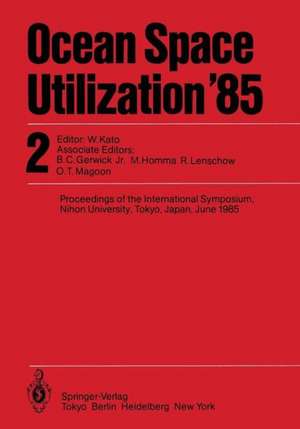Ocean Space Utilization ’85: Proceedings of the International Symposium Nihon University, Tokyo, Japan, June 1985 Volume 2
C.C. Mei Wataru Kato S. Motora, K. Okamura, J. Penzien, B.C. Jr. Gerwick, M. Homma, R. Lenschow, O.T. Magoonen Limba Engleză Paperback – 27 ian 2012
Preț: 669.52 lei
Preț vechi: 787.67 lei
-15% Nou
Puncte Express: 1004
Preț estimativ în valută:
128.13€ • 139.13$ • 107.63£
128.13€ • 139.13$ • 107.63£
Carte tipărită la comandă
Livrare economică 22 aprilie-06 mai
Preluare comenzi: 021 569.72.76
Specificații
ISBN-13: 9784431682868
ISBN-10: 4431682864
Pagini: 720
Ilustrații: 1468 p.
Dimensiuni: 178 x 254 x 38 mm
Greutate: 1.23 kg
Ediția:Softcover reprint of the original 1st ed. 1985
Editura: Springer
Colecția Springer
Locul publicării:Tokyo, Japan
ISBN-10: 4431682864
Pagini: 720
Ilustrații: 1468 p.
Dimensiuni: 178 x 254 x 38 mm
Greutate: 1.23 kg
Ediția:Softcover reprint of the original 1st ed. 1985
Editura: Springer
Colecția Springer
Locul publicării:Tokyo, Japan
Public țintă
ResearchDescriere
Ocean development has conventionally been targeted at the exploitation of natural resources, however this trend is gradually changing: Ocean space has itself come to be regarded as a precious resource. Since problems associated with energy, food supply, and population will become even more crucial over the coming years, ocean space is being reevaluated as a means for providing solutions in many of these areas. The future prosperity of mankind will to a large measure be dependent on the manner in which the resources of the oceans are utilized. To develop ocean space effectively, international cooperation is essential since a global perspective is paramount. It is on this basis of cooperation and communication that the present symposium was organized, bringing together experts from all over the world to report current findings in ocean development and to consider areas of future research. The material covered here deals with all aspects of these areas which are now of such of vital importance.
Cuprins
Special Session.- 3. Review of Ocean Space Utilization Projects.- SAGA Is A Long Range Autonomous Submarine.- An Analysis of Offshore Man-Made Islands.- Conception of Offshore Fishery Base.- Technical Session: Coastal Zone Utilization and Management.- 1. Coastal Zone Managemnt.- Urban Waterfront Revitalization.- Ocean Utilization and Economic Conflicts in the Coastal Zone.- A Direction and Policy for Coastal Zone Management in Japan.- Citizen Participation in Environmental Policy Making in the Coastal Area: Some Lessons from a Cross-National Study.- The Coastal Zone Atlas as a Potential Tool for Citizen Participation in Japanese Coastal Area Planning.- 2. Coastal Zone Planning.- An Activities Allocation Model Considering Interactive Effects for Coastal Zone Planning.- Marine Recreation: An Advancing Technology for Future Ocean Space Technology.- A Study on the Effect of the Location of the Sea City as a Solution to Urban Problems.- A Theoretical Study of the Ocean Space Utilization Planning for the Urban Coastal Water.- Waterfront Environment Planning for Urban Coastal Area.- 3. Development Project and Planning.- The Port Island Development in Kobe City as an Urban Complex Artificial Island.- Prerequisites for Ports and Harbors in the 21st Century: Case Study of Beppu Port.- Research on the Development of Deep Water Port of Taiwan District.- New Concept of Offshore Fishery Base for Effective Utilization of 200 Miles EEZ: A Method of Select the Position of Japanese Ocean Space.- A Case Study on a Project by a Fisheries Cooperative.- A Fundamental Consideration for the Fishery Environmental Impact Evaluation Using the Matrix Network Method.- 4. Coastal Process.- Changes in Littoral Processes due to Construction of Nearshore Structures.- Long-Term Prediction Model of Phosphorus in Bed Material.- Environmental Assessment of Waste Water Disposal from Sewage Treatment Plant: A Case Study.- Enhancement of Oceanic Productivity through Application of Municipal Sewage.- A New Model for a Prediction of Beach Deformation around a River Mouth.- Optimization of a Shore Protection Scheme for the West Coast of India.- 5. Environmental and Safety Management.- A Global Comparison of Contamination in Populated Estuaries and Coastal Waters.- Prevention of Escaping Oil from Mechanical Barriers in the Presence of Water Currents.- Interaction between Fresh Water and Sediment in Hachinohe Harbor.- Sensitivity of the Kuwait Coastal Environment to Potential Oil Spill Impact.- Some Problems of Environmental Investigation and Assessment.- The Utilization of Ocean Space for Waste Disposal: Changing Perspectives.- Marine Biotechnology and Pollution Control.- Ocean Dumping of Industrial Wastes.- 6. National and Regional Planning.- Planning for the Comprehensive Management of Ocean Space.- Coal Transhipment Centers: An Economic Development Potential for the Emerging Micronesian Governments in the Pacific.- Coastal Development and Governmkent’s Policies in Singapore.- Research on the Development of Wai-Shan-Ding Barrier, SW Coast of Taiwan, R.O.C..- The Ise Bay Management and Development Plan for the 21st Century.- East River Development Project.- Roles of Fishing Ports and Communities in Use and Control of the Sea.- Techniical Session: Materials and Construction.- 1. Design of Concrete.- Flexural Behavior of Ferrocement with Carbon Fiber Reinforced Cement as a Matrix.- Water Leak Tests of Ferrocement in Tension.- Polymer Concrete Composites for Concrete Ocean Structures.- Research on Resistance of Concrete to Seawater.- Specific Behavior of Structural Concrete in the Seas Pore Pressure Effects.- 2. Durability of Concrete.- Durability of Lightweight Concrete for Arctic Concrete Structures.- Static and Cyclic Behavior of Structural Lightweight Concrete at Cryogenic Temperatures.- Some Aspects of the Classificaitons of Pollution by Sea Water Water Aerosol for Reinforced Concrete Buildings.- Durability of Reinforced Concrete Structures in Marine Environment.- Life Time Test of Prestressed Concretes Various Measures of Protection against Corrosion in Splash Zones.- Developments of Protection Technologies for Concrete Structures in Marine Environment.- 3. Construction.- The Strength of the Drill Pipe for the Offshore Drilling.- Falling Behavior of a Pipe in the Sea.- Free Falling Installation Test of Artificial Steel Reef.- 4. Corrosion and Protection.- Corrosion Surveys of Steel Structures under Marine Environment.- Electrochemical Measurements of Corrosion and Biofouling Films on Simulated OTEC Heat Exchangers.- Atmospheric Exposed Test vs. Simulated Acceleration Test on Painted Test Piece.- Development and Progress of Anti-Corrosive Coating in the the Marine Atmosphere.- Exposure Tests of Corrosion-Protected Steel Pipe Piles in Marine Environment.- New Corrosion Control System for Steel Pipe Piles of the Oversea Bridge Footings.- A New Evaluation Method of Anti-Corrosive Properties of Heavy Duty Coating Systems for Offshore Structure Using Thermal Shock Technique.- Study of Corrosion-Protection Technologies in Splash and Tidal Zones: Establishment of Corrosion-Protection Technologies to Provide Long-Term Durability at Low Cost for Offshore Steel Structures by Use of Methods for Wrapping of Highly Corrosion-Resistant Metallic Materials.- Experiments on Repair of Corrosion Protective Coverings Applied to the Splash and Tidal Zones of Steel Pipe Piles.- Studies on the Paint System Applied to the Marine Steel Structure Simultaneously with Cathodic Protection.- Study on Cathodic Protection in Various Seawater Environments.- New Design Code for Cathodic Protection System of Maritime Steel Structures.- 5. New Concept.- Tremie Process Non-Contacting with Water.- A Concept of Large-Scale Artificial Ridges Using a New Hardened Product Made from Coal Ash.- Effective Uses of Pressed, Packed and Sealed Waste Blocks for Rubbles of Man-Made Fishing Strands in Shallow Seas.- 6. Ocean Structures.- Large Column-Supported Floating Platforms.- Design and Experiments of a Concrete Barge for LNG Storage.- Flexibility of TSG Platform to Project Requirements.- Study on the Fatigue Strength of Pressure Vessel Subjected to Internal Fluctuating Pressure: In the Case of 3% Saltwater as Pressure Medium.- Fatigue Strength of Tubular Joints.- Constructibility Engineering for Large Offshore Structure.- Concrete Platforms in the North Sea and Some Related Research on Fatigue.- Author Index.







